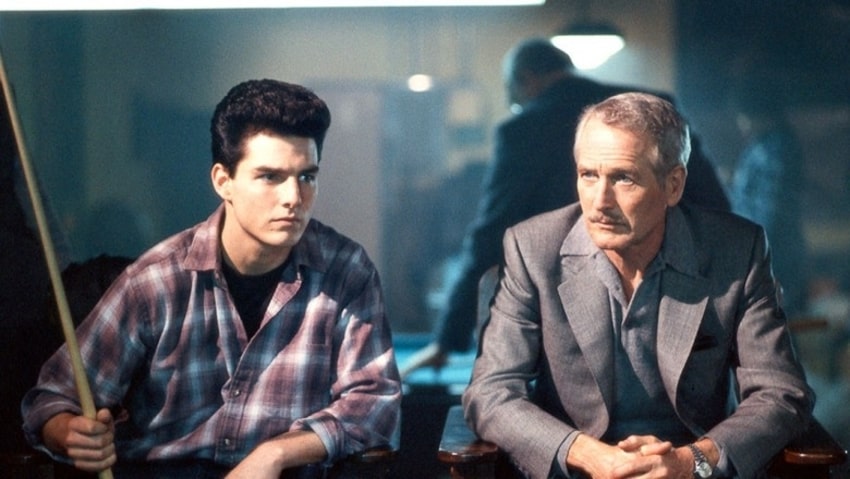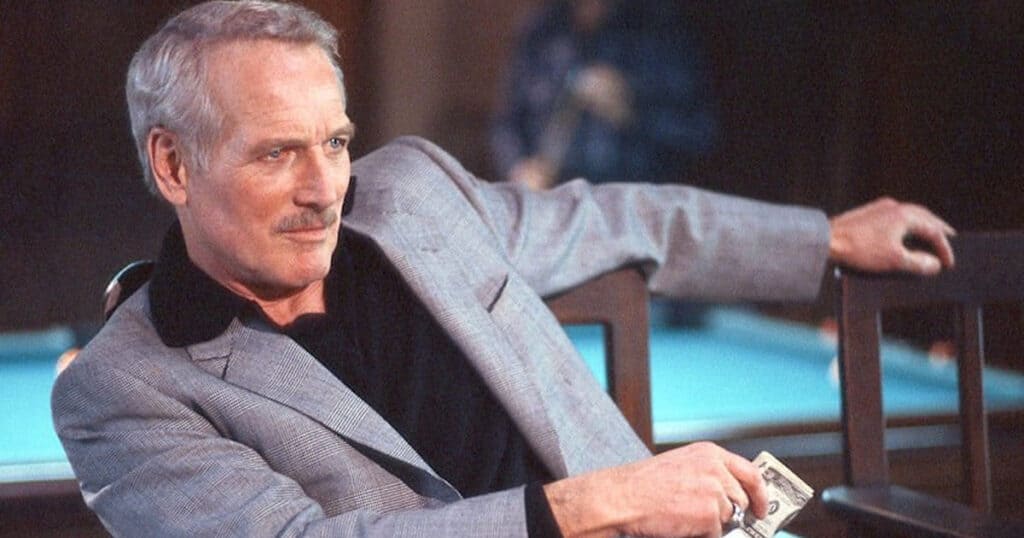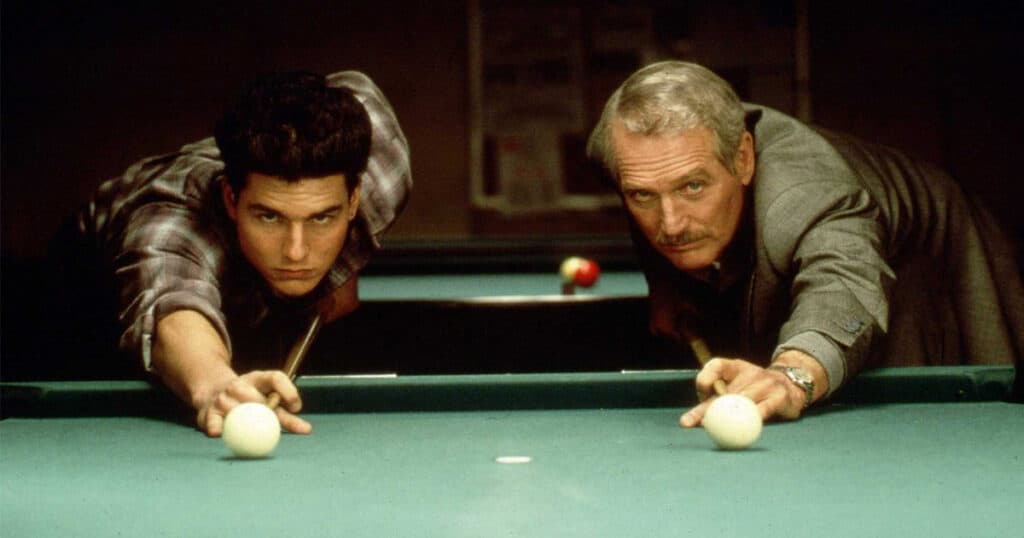
In 1986, Tom Cruise was on top of the world. Top Gun had come out and become the biggest movie of the year, minting him as a bonafide superstar. However, Cruise had bigger ambitions beyond being an action hero or heartthrob. He wanted to be a legitimate, respected actor; so before Top Gun ever hit theaters, he had already wrapped a role where he’d play opposite one of the biggest movies stars of all time – Paul Newman – whose career Cruise would likely want to emulate as the older actor was able to find the perfect balance between art and commerce, while never sacrificing his brand as a star. Their movie together – The Color of Money – would go on to be a highlight of both’s filmographies, and a notable gritty effort that paired them both, for the only time, with the great Martin Scorsese.
Flashback to 1961. Paul Newman was one of the biggest stars in the world, but his acting talent was never given its proper due. He was a heartthrob, but the great performances he’d become known for were in his future. Up to this point, his most acclaimed performance had been in the watered-down Tennesse Williams adaptation Cat on a Hot Tin Roof. To many, he lacked depth as an actor, which was explored in the recent Ethan Hawke documentary The Last Movie Stars. He was handsome, but was he a great actor? Any doubts would be put aside once audiences got a load of him as Fast Eddie Felson in Robert Rossen’s film The Hustler. In it, he’d play a pool hustler whose ambitions and pride get him into serious trouble, culminating in an intergenerational showdown with the great pool shark Minnesota Fats, played by the great one himself – Jackie Gleason. In the end, Felson is the victor, but the criminal element warns him that his days’ hustling pool are over or else. It’s a down-and-dirty movie for 1961, with Newman not always sympathetic as the impulsive, often cruel Fast Eddie. It was based on a novel by Walter Tevis, who also wrote The Queen’s Gambit, and over two decades later, the author revisited the character in his book The Color of Money.

The notion of revisiting his most famous character must have appealed to Newman at the time, who was riding a renewed wave of popularity in the wake of delivering perhaps his finest performance ever – in Sidney Lumet’s The Verdict. It was the first time Newman seemed to embrace middle age, and indeed he looked a lot different in the mid-eighties than he did in the early sixties. The notion of revisiting Fast Eddie in his middle age led to Newman pursuing Martin Scorsese as a director, with the star impressed by Raging Bull.
To note, Scorsese’s career was at a low ebb in 1986. While Raging Bull was Oscar-nominated, it hadn’t made any money, and the Me decade in Hollywood was all about generating cash and being commercially viable. Scorsese films didn’t fit the bill. The King of Comedy was another critical hit that didn’t make a dime, and his follow-up, After Hours was also a flop. Scorsese had ambitions to make large-scale movies like The Last Temptation of Christ, but to do so, he needed to prove to the studios that he could stay on schedule, on budget and deliver a hit as a hired gun.
However, even if The Color of Money wouldn’t be a passion project for Scorsese, the director was bent on making it as good as he could, which led to him ditching the Tevis novel in favour of an original screenplay by the great Richard Price.

We’d meet Fast Eddie deep into middle age in this new film. He hasn’t touched a pool cue in years, with him instead peddling knockoff brands of whisky to bars – which sounds like a comedown were it not for the fact that Fast Eddie’s charm has made him highly proficient at his job and earned him a comfortable living. He seems to have a solid life worked out for himself, even romancing a pretty bartender at one of the places he frequents, but one day he spies a young pool player with a shotgun break. That play is Tom Cruise’s Vince, who’s got the raw talent Fast Eddie used to have on the pool table. In it he spies the opportunity to make some money, exploiting Vince the same way he was once controlled in The Hustler. To his surprise, though, their con games reawaken his love of the game, leading to Fast Eddie again pinking up the pool cue, only to realize he’s no longer quite so fast and that Vince is a lot less naive than he seems.
What makes The Color of Money especially interesting is how filmmaking changed in the 25-year interval between 1961 and 1986. Recently Cruise had a massive hit with his legacy sequel Top Gun: Maverick, which was made at an even longer break, but Top Gun and Top Gun: Maverick feel closer in age than The Hustler and The Color of Money. So much had changed, and to his credit, Newman gave Scorsese (and cinematographer Michael Ballhaus) free reign to make a proper “Martin Scorsese Movie,” giving the film a genuine, contemporary vibe. The world of pool hustling has changed, with the pool halls no longer controlled by the mob. They have bigger fish to fry in the eighties, making the world less dangerous physically. Fast Eddie is annoyed by many things in his world, particularly how wannabes like John Turturro’s character dabble with cocaine, with even Eddie at one point saying how different the vibe was from the sixties when the big vice was booze. Scorsese’s choice of music is excellent in this, with him working with his usual music supervisor Robbie Robertson for a rock soundtrack that lends itself to some signature moments, including Vincent showboating to Warren Zevon’s “Werewolf of London”.

This brings me to the Cruise of it all. Top Gun hadn’t come out when Color of Money was cast, so people didn’t know how to peg Cruise. Would he be a flash-in-the-pan heartthrob like Christopher Atkins, or was he as legit as someone like Sean Penn? Scorsese took a risk on him that paid off, with the movie becoming a smash hit thanks to Cruise’s wave of megastardom following Top Gun. Cruise is excellent as Vince, evoking a great transition from being a smart-mouthed sheltered kid to a protege who learns how to pull one over on his mentor. He’s the movie’s villain rather than its hero, but it never judges him harshly. For most of the film, he’s being used, not only by Eddie but also by his trophy girlfriend (played by Mary Elizabeth Mastrantonio), who we learn was a thief that helped burgle Vince’s upper-class home before worming her way into his life. Vince starts off as a headstrong teen but eventually becomes a slick player, very much in the Tom Cruise movie star mode. It would be fascinating to see a legacy sequel to this movie get made – with Scorsese, of course – where Vince is now the older player mentoring someone younger. I wonder if Cruise can still play pool like he used to in the eighties, with him famously pulling off most of the trick shots featured in the movie.
Ultimately, the film was a major hit. The Color of Money earned over $52 million at the box office, a decent number for 1986. That was only about a third of what Top Gun made, but all involved were likely happy. It would help Scorsese get the funding for Last Temptation of Christ, while it would pave the way for Cruise to expand as a dramatic actor in Rain Man and Born on the Fourth of July. Mary Elizabeth Mastrantonio’s career would get a big boost, with her co-starring with Kevin Costner a few years later in Robin Hood: Prince of Thieves. Of everyone, though, the one who got the most out of this movie was Fast Eddie Felson, Paul Newman, who famously won an elusive Best Actor trophy at the Academy Awards, despite infamously losing for Cat on a Hot Tin Roof, The Hustler, Hud, Cool Hand Luke, Absence of Malice and – most inexplicably – The Verdict. Newman was so sure he’d lose he didn’t even attend the ceremony. He would always be grateful to Scorsese, mentioning the best piece of acting advice he ever got came from him when Scorsese told him to “stop trying to be funny.” The admiration went two ways, with Scorsese producing and appearing in Ethan Hawke’s recent The Last Movie Stars. Cruise wouldn’t work with Scorsese again, given how different the genres they typically work in are – but never say never. Give us a sequel, guys!
Have you seen Paul Newman and Tom Cruise in this awesome film directed by Martin Scorsese? Share your thoughts on The Color of Money by leaving a comment below.
For more on Paul Newman’s legacy – check out our interview with The Last Movie Stars director Ethan Hawke below:
The post The Color of Money (1986): Revisiting a Tom Cruise Classic appeared first on JoBlo.
Leave a Reply